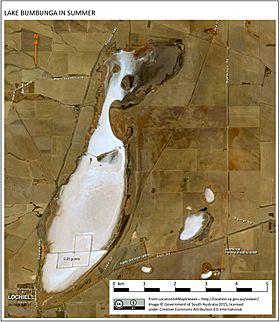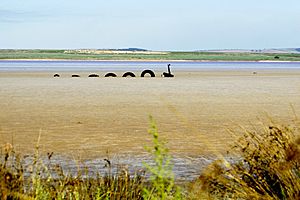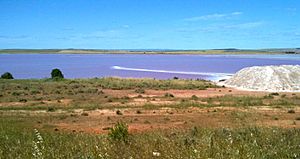Lake Bumbunga facts for kids
Quick facts for kids Lake Bumbunga |
|
|---|---|

Satellite view of 15 square km Lake Bumbunga in summer, when the water level is at its lowest
(click to enlarge) |
|
| Location | Mid North region, South Australia |
| Coordinates | 33°54′S 138°11′E / 33.900°S 138.183°E |
| Type | Salt lake |
| Basin countries | Australia |
| Surface area | 13.88 km2 (5.36 sq mi) |
Lake Bumbunga is a special salt lake found in South Australia. It's located in the Mid North region, between the towns of Lochiel and Bumbunga.
People have been collecting salt from this lake almost every year since 1881.
About Lake Bumbunga
The name Bumbunga comes from the local Aboriginal language, Parnpangka. It means "rain water lake."
Lake Bumbunga is easy to spot from Highway 1. You can see it for about 10 kilometers (6 miles). The lake covers about 15 square kilometers (5.8 square miles). It looks very different from the land around it. This is because of its amazing pink color, which changes with the seasons.
This lake is the biggest of many Holocene salt lakes in the area. These lakes stretch about 30 kilometers (19 miles) north of Lochiel. They collect water from an area east of the Barunga Range. When winter rains fill the lake, salt from the muddy ground dissolves into the water. In summer, much of the lake dries up, leaving the salt behind.
How Salt is Collected
Collecting salt from the lake is a natural process. First, salty water is left out in the sun and wind. This makes the water evaporate, leaving behind very salty water called brine. As the water evaporates, some less soluble parts like iron and gypsum fall out.
Then, this super salty water is moved into special areas called crystallizing ponds. Here, the common salt forms crystals and settles. The process stops before all the salt comes out. This prevents other unwanted salts, like magnesium and potassium, from mixing in. The remaining liquid, called bitterns, is drained away. The pure salt is then collected. At Lake Bumbunga, the brine goes into three large ponds, each about 25 hectares (62 acres) in size, for this final step.
History of Salt Mining
People first realized Lake Bumbunga was good for collecting salt in 1868. Salt harvesting began in the summer months of 1881. Just two years later, they were collecting 6 to 8 tonnes of salt every day!
Buildings for evaporating water, furnaces, and living quarters for workers were built. Salt mining created many jobs and helped the local economy. The town of Lochiel, located on the west side of the lake, grew because of this industry. Its survival in the 20th century depended almost entirely on salt harvesting.
By 1910, several companies were scraping thousands of tons of salt from the lake. This usually happened in December when the lake dried up. In 1913, the Australian Salt Company took over all the lake leases. This company later became part of Cheetham Salt Limited. Today, Cheetham Salt Limited is Australia's largest producer of solar salt.
Transporting the salt became much easier in 1926. A 9-kilometer (5.5-mile) railway line was built. This line connected the salt works directly to Port Adelaide. During World War II, salt was needed for making weapons. So, the number of workers increased from 30 to 100. They worked in three shifts a day, and two trains a week carried the bagged salt.
In 1967, about 1000 tonnes of salt were collected each day. At that time, South Australia produced 80% of Australia's salt. However, this percentage later dropped as other areas in Western Australia started producing more salt. Forty years later, the average yearly production was about 10,000 tonnes.
From 1996 to 2012, the salt works closed, and no salt was collected. Now, salt harvesting can be done with modern machines like front-end loaders and trucks. Because of this, the old maintenance and salt works buildings were no longer needed and were taken down in 2000.
Images for kids







